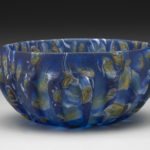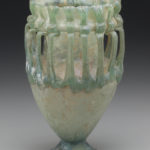Over thousands of years, glassmakers in the ancient Mediterranean produced stunning vessels incorporating a variety of manufacturing techniques and decorative schemes. From its origins in third millennium B.C. Mesopotamia to its widespread popularity in the Roman and Byzantine Empires, glassmaking underwent tremendous developments through periods of innovation and experimentation. Some trends quickly came in and out of style, while others revolutionized the industry.
This exhibit from the Yale University Art Gallery, which is home to one of the best collections of ancient glass in the United States, explores these vibrant displays of ancient technology and aesthetics. The pieces of glass on display range from second millennium B.C. New Kingdom Egypt to the seventh century A.D. Byzantine Empire and exemplify major manufacturing and decorative techniques.
- Deep Ribbed Bowl, Eastern Mediterranean, Alexandrian?, Graeco-Roman, 1st century B.C. – 1st century A.D. Dark blue glass with yellow and white, Yale University Art Gallery, Hobart and Edward Small Moore Memorial Collection, Bequest of Mrs. William H. Moore, 1955.6.17.
- Jar with 16 Handles, Roman, Eastern Mediterranean, 4th-5th century A.D.
Curated by Sara E. Cole, Yale University
Support provided by Home Federal Bank, UT Ready for the World, Aletha & Clayton Brodine Museum Fund, AARP, Knox County, the City of Knoxville, and the Arts & Heritage Fund.


